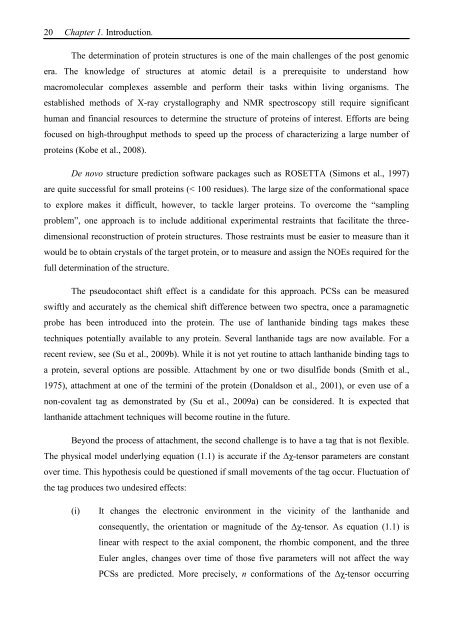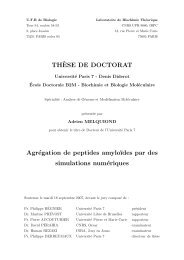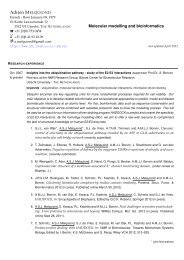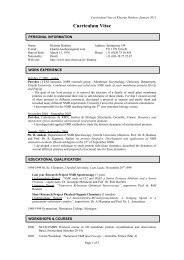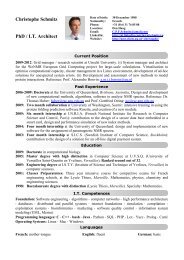Thesis Title: Subtitle - NMR Spectroscopy Research Group
Thesis Title: Subtitle - NMR Spectroscopy Research Group
Thesis Title: Subtitle - NMR Spectroscopy Research Group
You also want an ePaper? Increase the reach of your titles
YUMPU automatically turns print PDFs into web optimized ePapers that Google loves.
20 Chapter 1. Introduction.<br />
The determination of protein structures is one of the main challenges of the post genomic<br />
era. The knowledge of structures at atomic detail is a prerequisite to understand how<br />
macromolecular complexes assemble and perform their tasks within living organisms. The<br />
established methods of X-ray crystallography and <strong>NMR</strong> spectroscopy still require significant<br />
human and financial resources to determine the structure of proteins of interest. Efforts are being<br />
focused on high-throughput methods to speed up the process of characterizing a large number of<br />
proteins (Kobe et al., 2008).<br />
De novo structure prediction software packages such as ROSETTA (Simons et al., 1997)<br />
are quite successful for small proteins (< 100 residues). The large size of the conformational space<br />
to explore makes it difficult, however, to tackle larger proteins. To overcome the ―sampling<br />
problem‖, one approach is to include additional experimental restraints that facilitate the three-<br />
dimensional reconstruction of protein structures. Those restraints must be easier to measure than it<br />
would be to obtain crystals of the target protein, or to measure and assign the NOEs required for the<br />
full determination of the structure.<br />
The pseudocontact shift effect is a candidate for this approach. PCSs can be measured<br />
swiftly and accurately as the chemical shift difference between two spectra, once a paramagnetic<br />
probe has been introduced into the protein. The use of lanthanide binding tags makes these<br />
techniques potentially available to any protein. Several lanthanide tags are now available. For a<br />
recent review, see (Su et al., 2009b). While it is not yet routine to attach lanthanide binding tags to<br />
a protein, several options are possible. Attachment by one or two disulfide bonds (Smith et al.,<br />
1975), attachment at one of the termini of the protein (Donaldson et al., 2001), or even use of a<br />
non-covalent tag as demonstrated by (Su et al., 2009a) can be considered. It is expected that<br />
lanthanide attachment techniques will become routine in the future.<br />
Beyond the process of attachment, the second challenge is to have a tag that is not flexible.<br />
The physical model underlying equation (1.1) is accurate if the Δχ-tensor parameters are constant<br />
over time. This hypothesis could be questioned if small movements of the tag occur. Fluctuation of<br />
the tag produces two undesired effects:<br />
(i) It changes the electronic environment in the vicinity of the lanthanide and<br />
consequently, the orientation or magnitude of the Δχ-tensor. As equation (1.1) is<br />
linear with respect to the axial component, the rhombic component, and the three<br />
Euler angles, changes over time of those five parameters will not affect the way<br />
PCSs are predicted. More precisely, n conformations of the Δχ-tensor occurring


